UV-Cured Poly(Siloxane-Urethane)-Based Polymer Composite Materials for Lithium Ion Batteries—The Effect of Modification with Ionic Liquids
Abstract
1. Introduction
2. Materials and Methods
2.1. Materials
- The same anion as the anion in lithium salt, i.e., −CF3SO3− (TFS) and (CF3SO2)2N− (TFSI)
- Low viscosity, optionally also at low temperatures, and the melting point below −30 °C [75]
- Good compatibility with other components of the composite, both before and after curing, including capability to dissolve lithium salt
- Good specific conductivity at room temperature (around 10−3 Scm−1)
- No effect on surface tension of the composition before curing (to avoid defects of the film when the composition is cast on the substrate for curing)
- Minimum (optionally zero) water content
- Low price (if commercially available) or low production cost (if it is to be synthesized)
2.2. Methods
2.2.1. Synthesis of PSUR Prepolymer
2.2.2. Preparation of PSUR-Based UV-Cured Composites
2.2.3. Testing the Properties of PSUR-Based UV-Cured Composites
Conductivity Determinations
Preliminary Testing the Composites as Separators in Lithium Ion Batteries
Testing Thermal Properties of the Composites and ILs
Testing the Morphology of the Composites
Preparation of Samples for Mechanical Properties Testing and Solubility Experiments
FTIR Analysis
3. Results and Discussion
3.1. Effect of Modification with Non-Reactive ILs on Specific Conductivity of the PSUR-Based UV-Cured Composites
3.2. Effect of Modification with Non-Reactive ILs on Tg of the PSUR-Based UV-Cured Composites.
3.3. Effect of Modification with Reactive ILs on Specific Conductivity and Supramolecular Structure of the PSUR-Based UV-Cured Composites
3.4. Effect of Modification with Reactive ILs on Structure, Mechanical Properties and Tg of the PSUR-Based UV-Cured Composites
3.5. Effect of Modification with ILs on Morphology of the PSUR-Based UV-Cured Composites
3.6. Preliminary Testing of the Selected PSUR-Based UV-Cured Composite Film as Separator for Lithium Ion Batteries
4. Conclusions
Author Contributions
Funding
Acknowledgments
Conflicts of Interest
References
- Kozakiewicz, J.; Przybylski, J.; Sylwestrzak, K. Silicone-urethane membranes for lithium batteries. Part 1. Moisture-cured poly(siloxaneurethane-urea) elastomers containing polyethylene oxide (PEO) segments—Synthesis and characterization as potential membrane materials. Polym. Adv. Technol. 2016, 27, 258–265. [Google Scholar] [CrossRef]
- Kozakiewicz, J.; Przybylski, J.; Sylwestrzak, K. Synthesis and characterization of UV-cured poly(siloxane-urethane) elastomers containing polyethylene oxide segments—As potential membrane materials. Polimery 2019, 64, 18–28. [Google Scholar] [CrossRef]
- Song, M.; Cho, J.; Cho, B.W.; Rhee, H. Characterization of UV-cured gel polymer electrolytes for rechargeable lithium batteries. J. Power Sources 2002, 110, 209–215. [Google Scholar] [CrossRef]
- Song, M.; Kim, Y.; Kim, Y.T.; Cho, B.; Popov, N.; Rhee, H. Thermally stable gel polymer electrolytes. J. Electrochem. Soc. 2003, 150, A439–A444. [Google Scholar] [CrossRef]
- Gerbaldi, C. All-solid-state lithium-based polymer cells for high-temperature applications. Ionics 2010, 16, 777–786. [Google Scholar] [CrossRef]
- Nair, J.R.; Gerbaldi, C.; Meligrana, G.; Bongiovanni, R.; Bodoardo, S.; Penazzi, N.; Reale, P.; Gentili, V. UV-cured methacrylic membranes as novel gel–polymer electrolyte for Li-ion batteries. J. Power Sources 2008, 178, 751–757. [Google Scholar] [CrossRef]
- Gerbaldi, C.; Nair, J.R.; Meligrana, G.; Bongiovanni, R.; Bodoardo, S.; Penazzi, N. Highly ionic conducting methacrylic-based gel polymer electrolytes by UV-curing technique. J. Appl. Electrochem. 2009, 39, 2199–2207. [Google Scholar] [CrossRef]
- Porcarelli, L.; Gerbaldi, C.; Bella, F.; Nair, J.R. Super soft all-ethylene oxide polymer electrolyte for safe all-solid lithium batteries. Sci. Rep. 2016, 6, 19892. [Google Scholar] [CrossRef]
- Kil, E.H.; Choi, K.H.; Ha, H.J.; Xu, S.; Rogers, J.H.; Kim, M.R.; Lee, Y.G.; Kim, K.M.; Cho, K.Y.; Lee, S.Y. Imprintable, bendable and shape-conformable polymer electrolytes for versatile-shaped lithium-ion batteries. Adv. Mater. 2013, 25, 1395–1400. [Google Scholar] [CrossRef]
- Imperiyka, M.; Ahmad, A.; Hanifah, S.A.; Rahman, M.Y.A. Potential UV-curable poly(glycidyl methacrylate-co-ethyl methacrylate)- based solid polymer electrolyte for lithium ion battery application. Int. J. Electrochem. Sci. 2013, 8, 10932–10945. [Google Scholar]
- Oh, B.; Jung, W.I.; Kim, D.W.; Rhee, H.W. Preparation of UV-curable gel polymer electrolytes and their electrochemical properties. Bull. Korean Chem. Soc. 2002, 23, 683. [Google Scholar] [CrossRef][Green Version]
- Gerbaldi, C.; Nair, J.R.; Meligrana, G.; Bongiovanni, R.; Bodoardo, S.; Penazzi, N. UV-curable siloxane-acrylate gel copolymer electrolytes for lithium-based battery applications. Electrochim. Acta 2010, 55, 1460–1467. [Google Scholar] [CrossRef]
- Destro, M.; Gerbaldi, C.; Bella, F.; Nair, J.R. Siloxane diacrylate-based all solid polymer electrolytes for lithium batteries. Int. J. Membr. Sci. Technol. 2015, 2, 23–27. [Google Scholar] [CrossRef]
- Kim, C.S.; Kim, B.H.; Kim, K. Synthesis and characterization of polyether urethane acrylate-LiCF3SO3-based polymer electrolytes by UV-curing in lithium batteries. J. Power Sources 1999, 84, 12–23. [Google Scholar] [CrossRef]
- Ugur, M.H.; Kihc, H.; Berkem, M.L.; Gungor, A. Synthesis by UV-curing and characterization of polyurethane acrylate-lithium salts-based polymer electrolytes in lithium batteries. Chem. Pap. 2014, 68, 1561–1572. [Google Scholar] [CrossRef]
- Susan, M.A.B.H.; Kaneko, T.; Noda, A.; Watanabe, M. Ion gels prepared by in situ radical polymerization of vinyl monomers in an ionic liquid and their characterization as polymer electrolytes. J. Am. Chem. Soc. 2005, 127, 4976–4983. [Google Scholar] [CrossRef]
- Nakagawa, H.; Izuchi, S.; Kuwana, K.; Nukuda, T.; Aichara, Y. Liquid and polymer gel electrolytes for lithium batteries composed of room-temperature molten salt doped by lithium salt. J. Electrochem. Soc. 2003, 150, A695–A700. [Google Scholar] [CrossRef]
- Ohno, H. (Ed.) Electrochemical Aspects of Ionic Liquids; John Wiley & Sons: Hoboken, NJ, USA, 2005. [Google Scholar]
- Ye, Y.S.; Rick, J.; Hwang, B.J. Ionic liquid polymer electrolytes. J. Mater. Chem. A 2013, 1, 2719–2743. [Google Scholar] [CrossRef]
- Karuppassamy, K.; Theerthagiri, J.; Vikraman, G.; Yim, C.J.; Hussain, S.; Sharma, R.; Maiyalagan, T.; Qin, J.; Kim, H.S. Ionic liquid-based electrolytes for energy storage devices; A bief review of their limits and applications. Polymers 2020, 12, 918. [Google Scholar] [CrossRef] [PubMed]
- Gerbaldi, C.; Nair, J.R.; Ahmad, S.; Meligrana, G.; Bongiovanni, R.; Bodoardo, S.; Penazzi, N. UV-cured polymer electrolytes encompassing hydrophobic room temperature ionic liquid for lithium batteries. J. Power Sources 2010, 195, 1706–1713. [Google Scholar] [CrossRef]
- Nair, J.R.; Porcarelli, R.; Bella, F.; Gerbaldi, C. Newly elaborated multipurpose polymer electrolyte encompassing RTILs for smart energy-efficient devices. ACS Appl. Mater. Interfaces 2015, 7, 12961–12971. [Google Scholar] [CrossRef] [PubMed]
- Woo, H.S.; Son, H.; Min, J.Y.; Rhee, J.; Lee, H.T.; Kim, D.W. Ionic liquid-based gel polymer electrolyte containing zwitterion for lithium oxygen batteries. Electrochim. Acta 2020, 345, 136348. [Google Scholar] [CrossRef]
- Porcarelli, K.; Manojkumar, K.; Sardon, H.; Llorente, O.; Shaplov, A.S.; Vijayakrishna, K.; Gerbaldi, C.; Mecerreyes, D. Single ion conducting polyemnr electrolytes based on versatile polyurethanes. Electrochim. Acta 2017, 241, 526–534. [Google Scholar] [CrossRef]
- Chaudoy, V.; Tran Van, F.; Deschamps, M.; Ghamouss, F. Ionic liquids in a polyethylene oxide cross-linked gel polymer as an electrolyte for electrical double layer capacitor. J. Power Sources 2017, 342, 872–878. [Google Scholar] [CrossRef]
- Rupp, B.; Schmuck, M.; Balducci, A.; Winter, M.; Kern, W. Polymer electrolyte for lithium batteries based on photochemically crosslinked poly(ethylene oxide) and ionic liquid. Euro. Polym. J. 2008, 44, 2986–2990. [Google Scholar] [CrossRef]
- Stępniak, I.; Andrzejewska, E.; Debna, A.; Galiński, M. Characterization and application of N-methyl-N-propylpiperidinium bis (trifluormethhanesulfonyl)imide ionic liquid-based gel polymer electrolyte prepared in situ by photopolymerization method in lithium batteries. Electrochim. Acta 2014, 121, 27–33. [Google Scholar] [CrossRef]
- Sigma Aldrich and Fluka Leaflet: “Enabling Technologies—Ionic Liquids”, Chem. Files vol. 5 No. 6. Available online: https://www.yumpu.com/en/document/read/6902632/vol-5-no-6-on-ionic-liquids-sigma-aldrich (accessed on 28 September 2020).
- Welton, T. Room temperature ionic liquids. Solvents for synthesis and catalysis. Chem. Rev. 1999, 99, 2071–2084. [Google Scholar] [CrossRef]
- Lu, J.; Yan, F.; Texter, J. Advanced applications of ionic liquids in polymer science. Progr. Polym. Sci. 2009, 34, 431–448. [Google Scholar] [CrossRef]
- Keskin, S.; Kayrak-Talay, D.; Akman, U.; Hortacsu, O. A review of ionic liquids towards supercritical fluid applications. Supercrit. Fluids 2007, 43, 150–180. [Google Scholar] [CrossRef]
- Pernak, J.; Walkiewicz, F.; Maciejewska, M.; Zaborski, M. Ionic liquids as vulcanization accelerators. Ind. Eng. Chem. Res. 2010, 49, 5012–5017. [Google Scholar] [CrossRef]
- Tsuda, T.; Hussey, C.L. Electrochemical applications of room-temperature ionic liquids. Electrochem. Soc. Interface 2007, 16, 42–49. [Google Scholar]
- Silvester, D.S.; Compton, G. Electrochemistry in room temperature ionic liquids; A review and some possible applications. Z. Phys. Chem. 2006, 220, 1247–1274. [Google Scholar] [CrossRef]
- Hasanzadeh, M.; Shadjou, N.; Eskandani, M.; de la Guardia, M. Room-temperature ionic liquid-based electrochemical nanobiosensors. TrAC Trends Anal. Chem. 2012, 41, 58–74. [Google Scholar] [CrossRef]
- Paul, A.; Muthukumar, S.; Prasad, S. Review—Room temperature ionic liquids for electrochemical applications with special focus on gas sensors. J. Electrochem. Soc. 2020, 167, 037511. [Google Scholar] [CrossRef]
- Kim, G.T.; Appetecchi, G.B.; Carewska, M.; Joost, M.; Balducci, A.; Winter, M.; Passerini, S. UV-crosslinked, lithium conducting ternary polymer electrolytes containing ionic liquids. J. Power Sources 2010, 195, 6130–6137. [Google Scholar] [CrossRef]
- Shaplov, A.S.; Marcilla, R.; Mecerreyes, D. Recent advances in innovative polymer electrolytes based on poly(ionic liquid)s. Electrochim. Acta 2015, 175, 18–34. [Google Scholar] [CrossRef]
- Lewandowski, A.; Świderska-Mocek, A. Ionic liquids as electrolytes for Li-ion batteries—An overview of electrochemical studies. J. Power Sources 2009, 194, 601–609. [Google Scholar] [CrossRef]
- Kim, G.T.; Passerini, S.; Carewska, M.; Appetecchi, G.B. Ionic liquid-based electrolyte membranes for medium-high temperature lithium polymer batteries. Membranes 2018, 8, 41. [Google Scholar] [CrossRef]
- Polu, A.R.; Rhee, H.W. Ionic liquid doped PEO-based solid polimer electrolytes for lithium ion polymer batteries. Int. J. Hydrog. Energy 2017, 32, 7212–7219. [Google Scholar] [CrossRef]
- Diaw, M.; Chagnes, A.; Carre, B.; Willmann, P.; Lemordant, D. Mixed ionic liquid as electrolyte fpr lithium batteries. J. Power Sources 2005, 144, 682–684. [Google Scholar] [CrossRef]
- Gao, X.; Wu, F.; Mariani, A.; Passerini, S. Concentrated ionic-liqid-based electrolytes for high voltage lithium batteries with improved performance at room temperature. ChemSusChem 2019, 12, 4185–4193. [Google Scholar] [CrossRef]
- Elia, G.A.; Ulissi, U.; Jeong, S.; Passerini, S.; Hassoun, J. Exceptional long-life performance of lithium-ion batteries using ionic liquid-based electrolytes. Energy Environ. Sci. 2017, 9, 3210–3220. [Google Scholar] [CrossRef]
- Francis, C.F.J.; Kyratzis, Y.R.; Best, A.S. Lithium-ion battery separators for ionic-liquid electrolytes: A Review. Adv. Mater. 2020, 32, 1904205. [Google Scholar] [CrossRef] [PubMed]
- Kirchhofer, M.; von Zamory, J.; Paillard, E.; Passerini, S. Separators for Li-ion and Li-metal battery including ionic liquid based electrolytes based on the TFSI- and FSI- anions. Int. J. Mol. Sci. 2014, 15, 14868–14890. [Google Scholar] [CrossRef]
- Xiang, Y.; Li, J.; Lei, J.; Liu, D.; Xie, Z.; Qu, D.; Li, K.; Deng, T.; Tang, H. Advanced separators for lithium-ion and lithium-sulfur batteries: A review of recent progress. ChemSusChem 2016, 9, 3023–3039. [Google Scholar] [CrossRef] [PubMed]
- Ueki, T.; Watanabe, M. Macromolecules in ionic liquids; progress, challenges and opportunities. Macromolecules 2008, 41, 3739–3749. [Google Scholar] [CrossRef]
- Eftekhari, A.; Chen, P. Different roles of ionic liquids in lithium batteries. J. Power Sources 2016, 334, 221–239. [Google Scholar] [CrossRef]
- Kumar, Y.; Hashmi, S.A.; Pandey, G.P. Lithium ion transport and ion–polymer interaction in PEO based polymer electrolyte plasticized with ionic liquid. Solid State Ion. 2011, 201, 73–80. [Google Scholar] [CrossRef]
- Park, M.; Zhang, X.; Chung, M.; Less, G.B.; Sastry, A.M. A review of conduction phenomena in Li-ion batteries. J. Power Sources 2010, 195, 7904–7929. [Google Scholar] [CrossRef]
- Oltean, G.; Plylahan, L.; Ihrfors, C.; Wei, W.; Xu, C.; Edstroem, K.; Nyholm, L.; Johansson, P.; Gustaffson, T. Towards Li-ion batteries operating at 80 °C: Ionic liquid versus conventional liquid electrolytes. Batteries 2018, 4, 2. [Google Scholar] [CrossRef]
- Marsh, K.N.; Boxall, J.A.; Lichtenthaler, R. Room temperature ionic liquids and their mixtures—A review. Fluid Phase Equilibria 2004, 219, 93–98. [Google Scholar] [CrossRef]
- Patel, R.; Seo, J.A.; Koh, J.H.; Kim, J.H.; Kang, Y.S. Dye-sensitized solar cells employing amphiphilic poly(ethylene glycol) electrolytes. J. Photochem. Photobiol. A Chem. 2011, 217, 169–176. [Google Scholar] [CrossRef]
- Kim, G.T.; Appetecchi, G.B.; Alessandrini, F.; Passerini, S. Solvent-free, PYR1ATFSI ionic liquid-based ternary polymer electrolyte systems. J. Power Sources 2007, 171, 861–869. [Google Scholar] [CrossRef]
- Abitelli, E.; Ferrari, S.; Quartarone, E.; Mustarelli, P.; Magistris, A.; Fagnoni, M.; Albini, A.; Gerbaldi, C. Polyethylene oxide electrolyte membranes with pyrrolidinium-based ionic liquids. Electrochim. Acta 2010, 55, 5478–5484. [Google Scholar] [CrossRef]
- Shin, J.H.; Henderson, W.A.; Passerini, S. PEO-Based Polymer Electrolytes with Ionic Liquids and Their Use in Lithium Metal-Polymer Electrolyte Batteries. J. Electrochem. Soc. 2005, 152, 978–983. [Google Scholar] [CrossRef]
- Cheng, H.; Zhu, C.; Huang, B.; Lu, M.; Yong, Y. Synthesis and electrochemical characterization of PEO-based polymer electrolytes with room temperature ionic liquids. Electrochim. Acta 2007, 52, 5789–5794. [Google Scholar] [CrossRef]
- Singh, P.K.; Kim, K.W.; Rhee, H.W. Development and characterization of ionic liquid doped solid polymer electrolyte membranes for better efficiency. Synth. Metals 2009, 159, 1538–1541. [Google Scholar] [CrossRef]
- Singh, P.K.; Kim, K.W.; Rhee, H.W. Electrical, optical and photoelectrochemical studies on a solid PEO-polymer electrolyte doped with low viscosity ionic liquid. Electrochem. Commun. 2008, 10, 1769–1772. [Google Scholar] [CrossRef]
- Dobbelin, M.; Azcune, I.; Bedu, M.; Ruiz de Luzuriaga, A.; Genua, A.; Jovanovski, V.; Cabanero, G.; Odriozola, I. Synthesis of pyrrolidinium-based poly(ionic liquid) electrolytes with poly(ethylene glycol) side chains. Chem. Mater. 2012, 24, 1583–1590. [Google Scholar] [CrossRef]
- Zygadło-Monikowska, E.; Florjańczyk, Z.; Służewska, K.; Ostrowska, J.; Langwald, N.; Tomaszewska, A. Lithium conducting ionic liquids based on lithium borate salts. J. Power Sources 2010, 195, 6055–6061. [Google Scholar] [CrossRef]
- Stępniak, I.; Andrzejewska, E. Highly conductive ionic liquid based ternary polymer electrolytes obtained by in situ photopolymerization. Electrochim. Acta 2009, 54, 5660–5665. [Google Scholar] [CrossRef]
- Matsumoto, K.; Talukdar, B.; Endo, T. Methacrylate-based ionic liquid: Radical polymerization/copolymerization with methyl methacrylate and evaluation of molecular weight of the obtained homopolymers. Polym. Bull. 2011, 66, 199–210. [Google Scholar] [CrossRef]
- Eshetu, G.G.; Mecerreyes, D.; Forsyth, M.; Zhang, H.; Armand, M. Polymeric ionic liquids for lithium-based rechargeable batteries. Mol. Syst. Des. Eng. 2019, 4, 294–309. [Google Scholar] [CrossRef]
- Yang, G.; Song, Y.; Wang, Q.; Zhang, L.; Deng, L. Review of ionic liquids-containing polymer/inorganic hybrid electrolytes for lithium batteries. Mater. Des. 2020, 190, 108563. [Google Scholar] [CrossRef]
- Braga, M.H.; Grundish, N.S.; Murchison, A.J.; Goodenough, J.B. Alternative strategy for a safe rechargeable battery. Energy Environ. Sci. 2017, 10, 331–336. [Google Scholar] [CrossRef]
- Zhou, D.; Liu, R.; Zhang, J.; Qi, X.; He, Y.-B.; Li, B.; Yang, Q.-H.; Hu, Y.-S.; Kang, F. In situ synthesis of hierarchical poly(ionic liquid)-based solid electrolytes for high-safety lithium-ion and sodium-ion batteries. Nano Energy 2017, 33, 45–54. [Google Scholar] [CrossRef]
- Ma, F.; Zhang, Z.; Yan, W.; Ma, X.; Sun, D.; Jin, Y.; Chen, X.; He, K. Solid polymer electrolyte based on polymerized ionic liquid for high performance all-solid-state lithium-ion batteries. ACS Sustain. Chem. Eng. 2019, 7, 4675–4683. [Google Scholar] [CrossRef]
- Sato, T.; Marukane, S.; Narutomi, T.; Akao, T. High rate performance of a lithium polymer battery using a novel ionic liquid polymer composite. J. Power Sources 2007, 164, 390–396. [Google Scholar] [CrossRef]
- Nykaza, J.R.; Savage, A.M.; Pan, Q.; Wang, S.; Beyer, F.L.; Tang, M.H.; Li, C.Y.; Elabd, Y.A. Polymerized ionic liquid diblock copolymer as solid-state electrolyte and separator in lithium-ion battery. Polymer 2016, 101, 311–318. [Google Scholar] [CrossRef]
- D’Angelo, A.J.; Panzer, M.J. Decoupling the ionic conductivity and elastic modulus of gel electrolytes: Fully zwitterionic copolymer scaffolds in lithium salt/ionic liquid solutions. Adv. Energy Mater. 2018, 8, 1801646. [Google Scholar] [CrossRef]
- Kozakiewicz, J.; Przybylski, J.; Sylwestrzak, K. A Method of Making an Electroconductive Composite. PL Pat. 219192 B1, 31 March 2015. [Google Scholar]
- Kozakiewicz, J.; Cybulski, J.; Przybylski, J.; Sylwestrzak, K.; Wisniewska, A. A Method of Making an Electroconductive Composite. PL Pat. 219277 B1, 30 April 2015. [Google Scholar]
- Katritzky, A.R.; Lomaka, A.; Petrukhin, R.; Jain, R.; Karelson, M.; Visser, A.E.; Rogers, R.D. Room temperature ionic liquids and their mixtures—A review. J. Comp. Info. Comp. Sci. 2002, 41, 71–74. [Google Scholar] [CrossRef]
- Liu, L.; Zheng, Z.; Gu, C.; Wang, X. The poly(urethane-ionic liquid)/multiwalled carbon nanotubes composites. Compos. Sci. Technol. 2010, 70, 1697–1703. [Google Scholar] [CrossRef]
- Appetecchi, G.B.; Kim, G.T.; Montanino, M.; Alessandrini, F.; Passerini, S. Room temperature lithium polymer batteries based on ionic liquids. J. Power Sources 2011, 196, 6703–6709. [Google Scholar] [CrossRef]
- Gray, F.M. Solid Polymer Electrolytes: Fundamentals and Technological Applications; VCH Publishers. Inc.: Weinhiem, Germany, 1991. [Google Scholar]
- Kharel, A.; Lodge, T.P. Effect of ionic liquid components on coil dimensions of PEO. Macromolecules 2019, 52, 3123–3130. [Google Scholar] [CrossRef]
- Kharel, A.; Lodge, T.P. Coil dimensions of poly(ethylene oxide) in an ionic liquid by small-angle neutron scattering. Macromolecules 2017, 50, 8739–8744. [Google Scholar] [CrossRef]
- Hamankiewicz, B.; Czerwiński, A.; Krajewski, M.; Michalska, M.; Lipińska, L.; Kozakiewicz, J.; Przybylski, J.; Sylwestrzak, K.; Sarna, W. Lithium-Ion Cell. WO 2017/168330 A1, 5 October 2017. [Google Scholar]

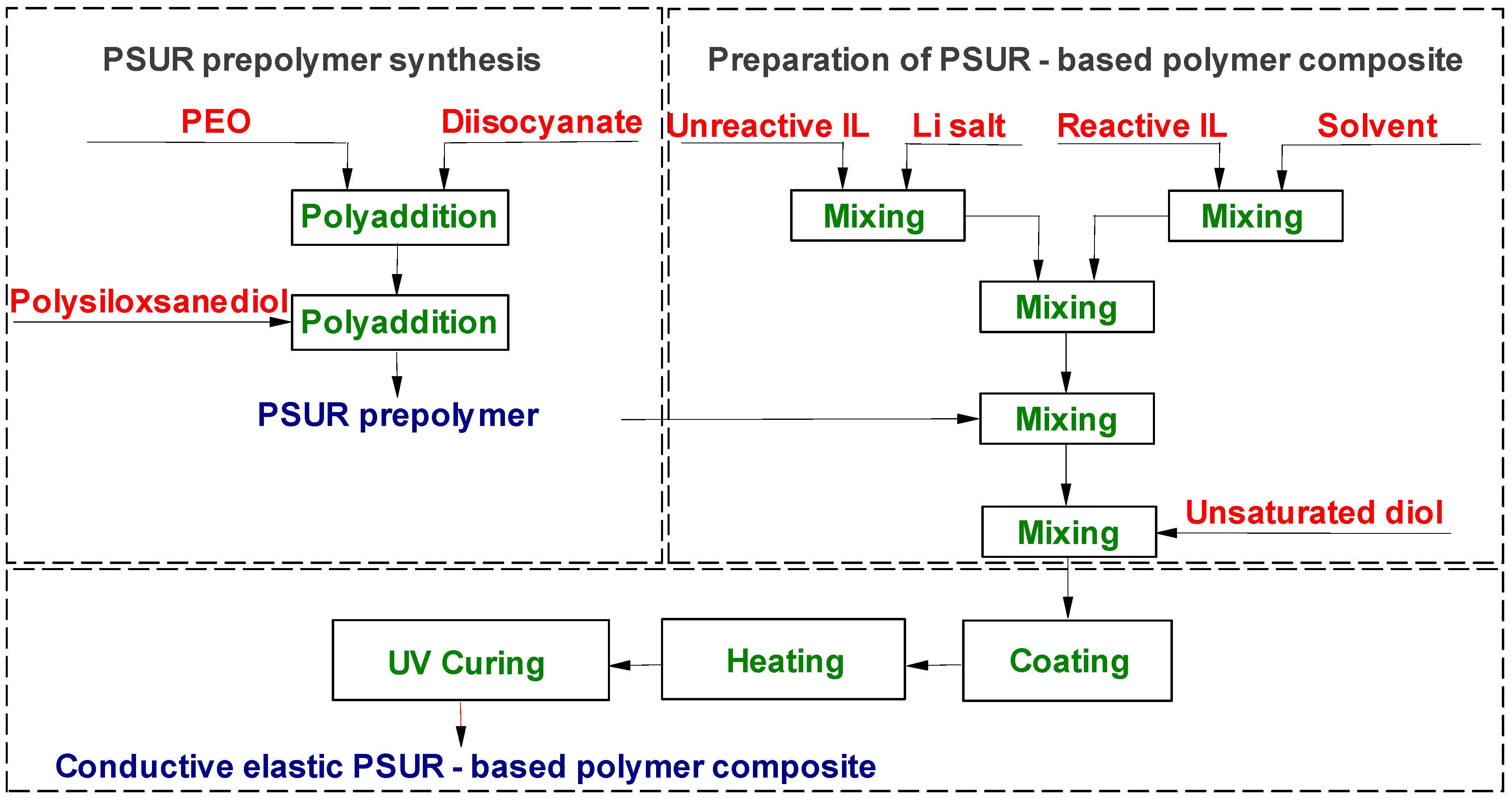

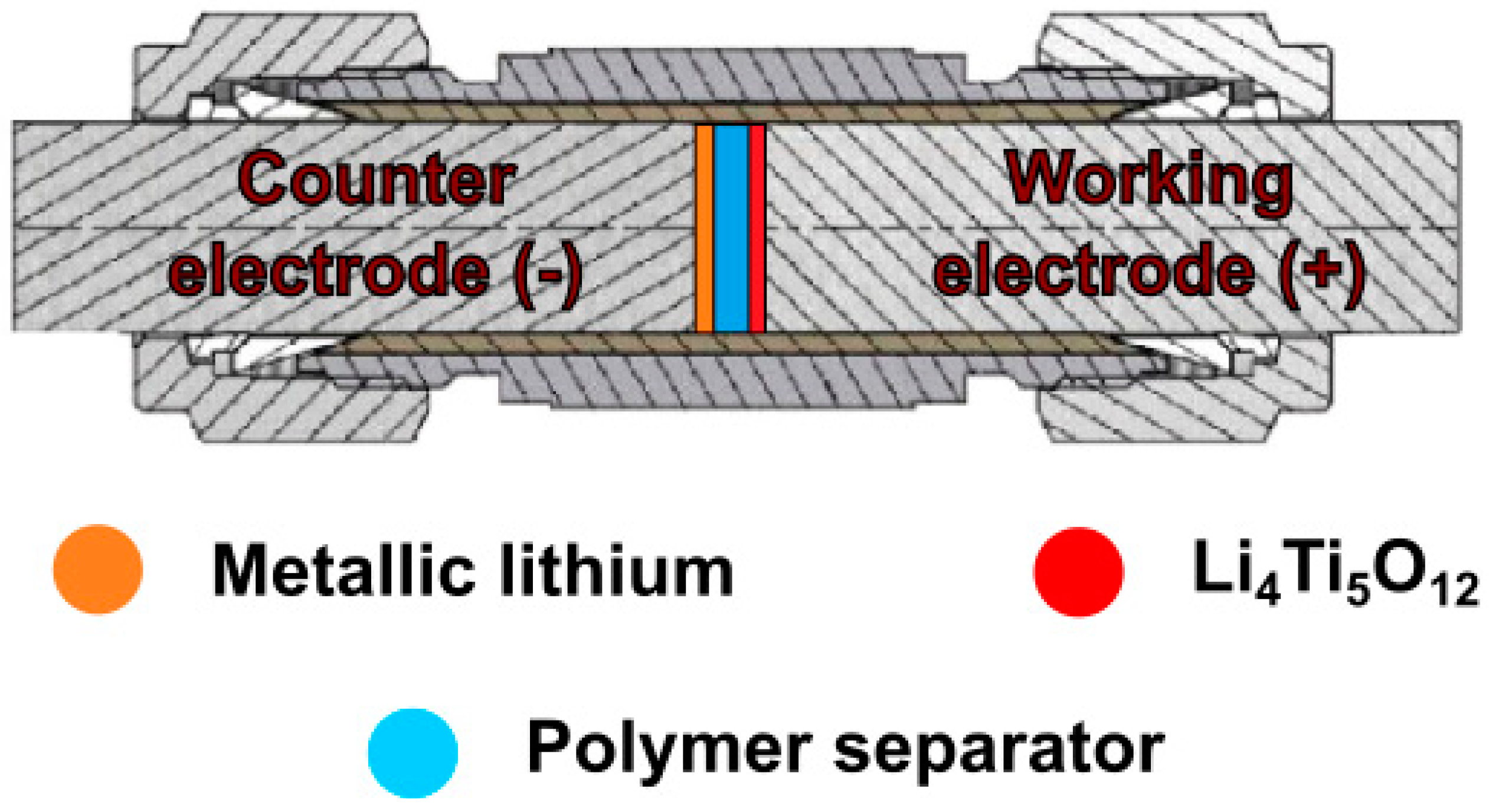


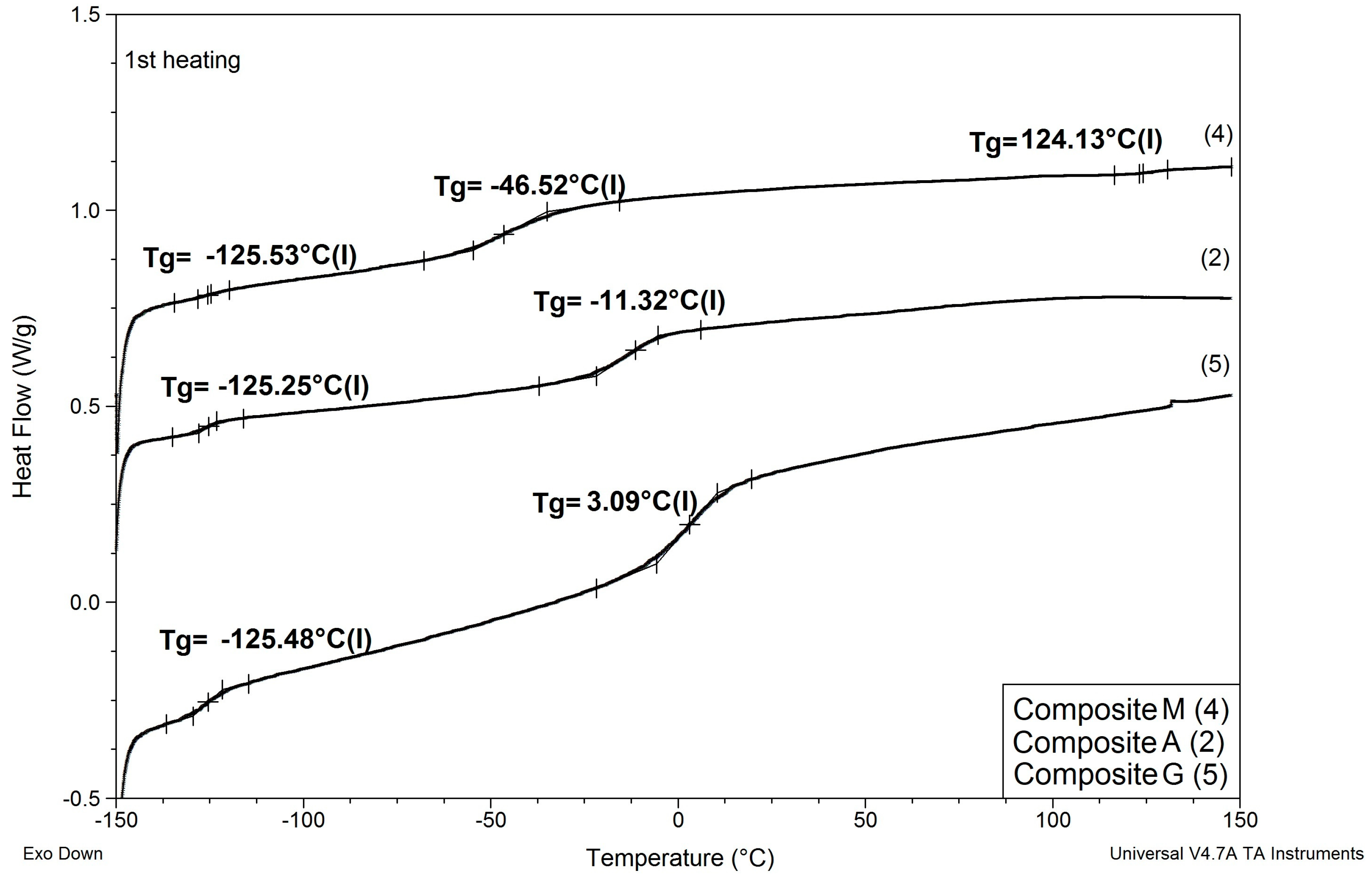
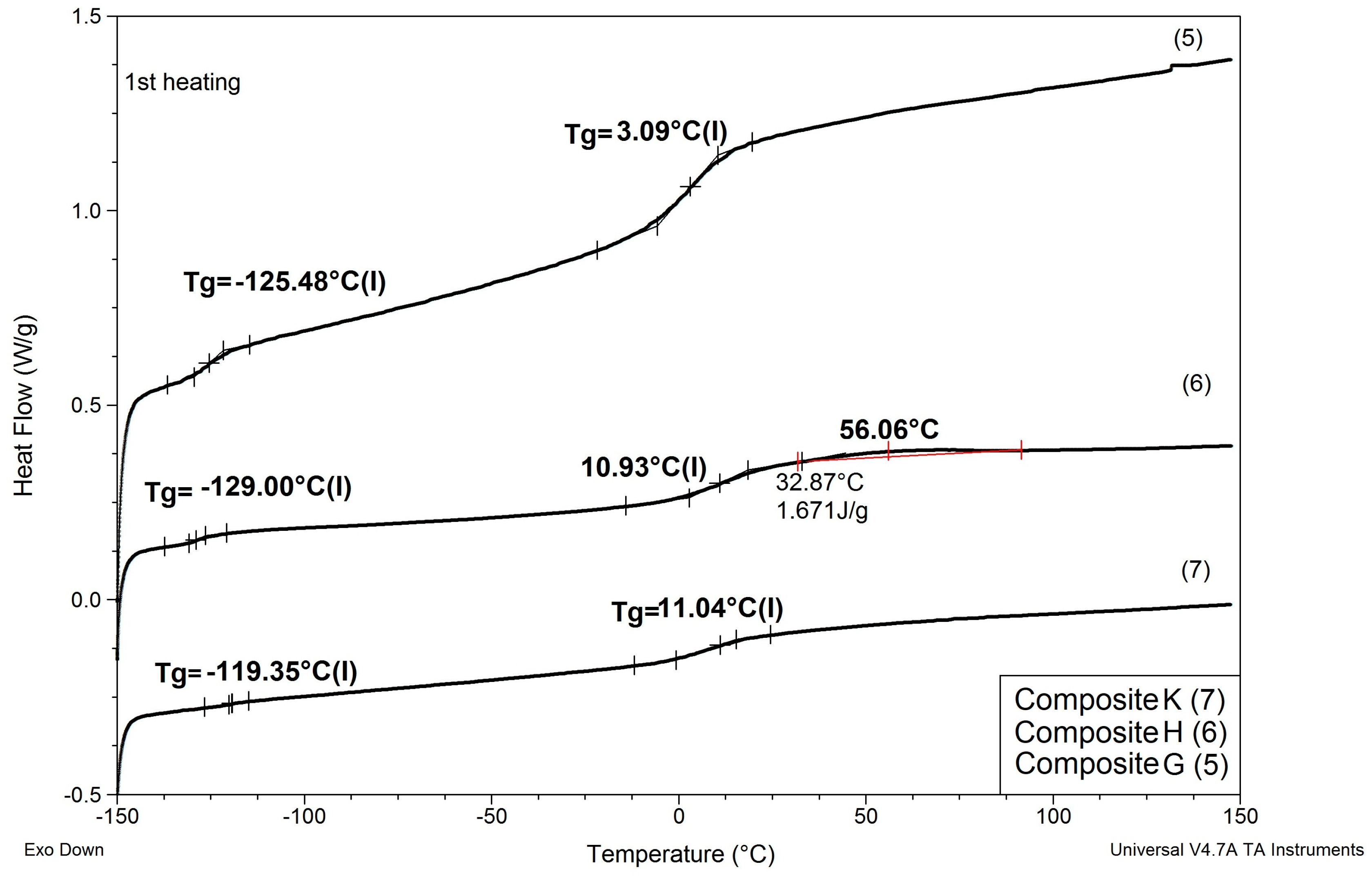
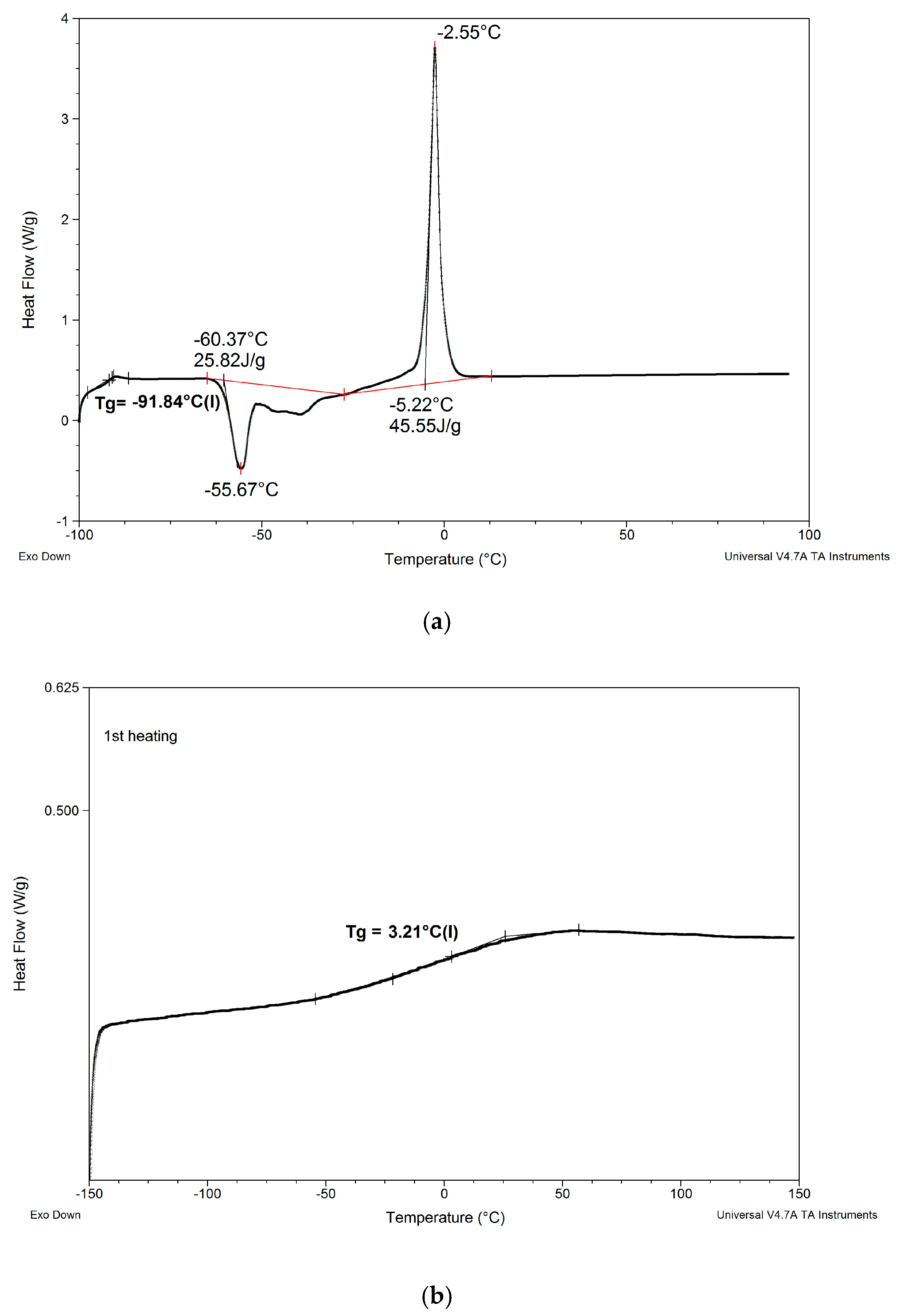



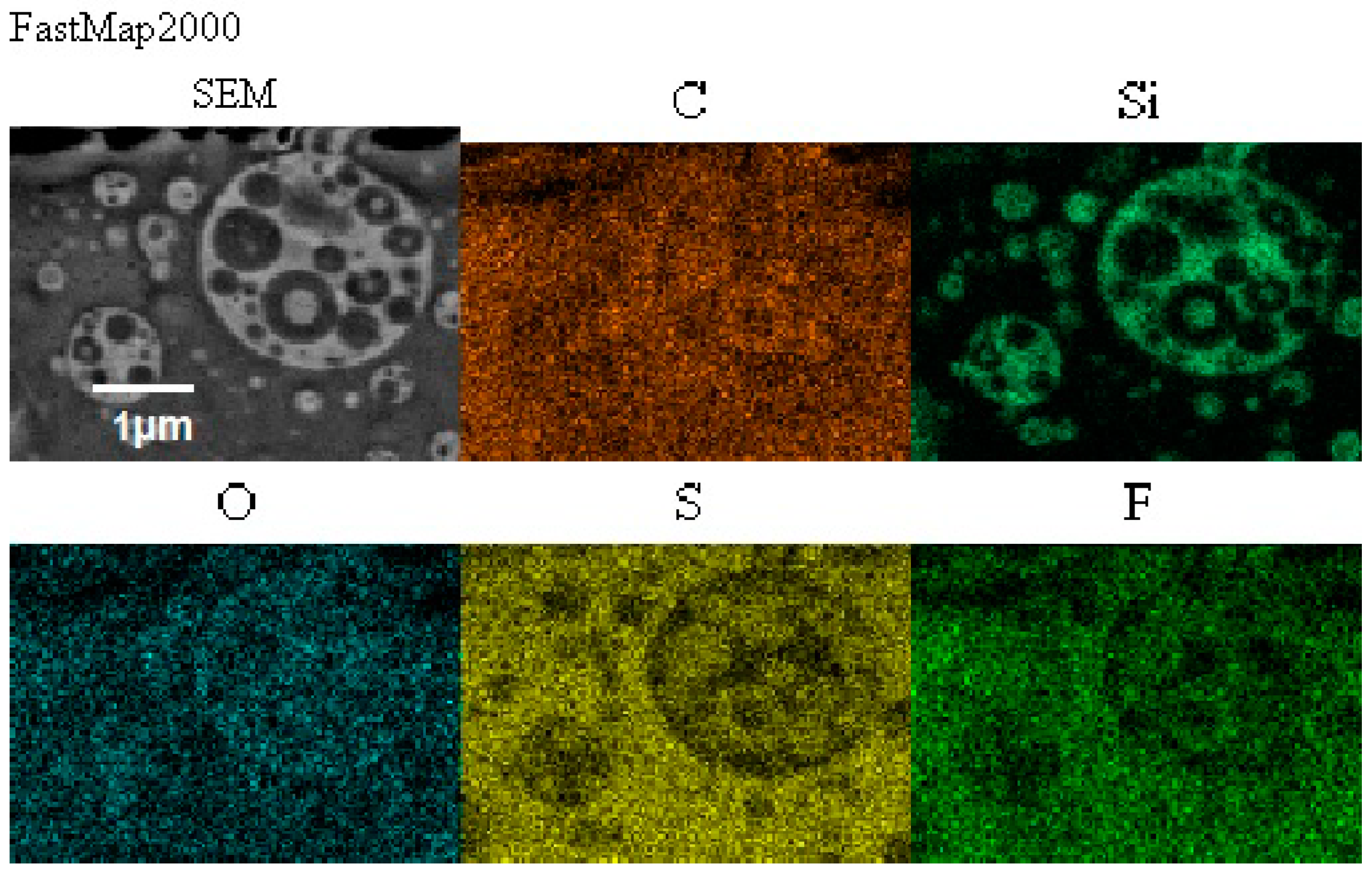

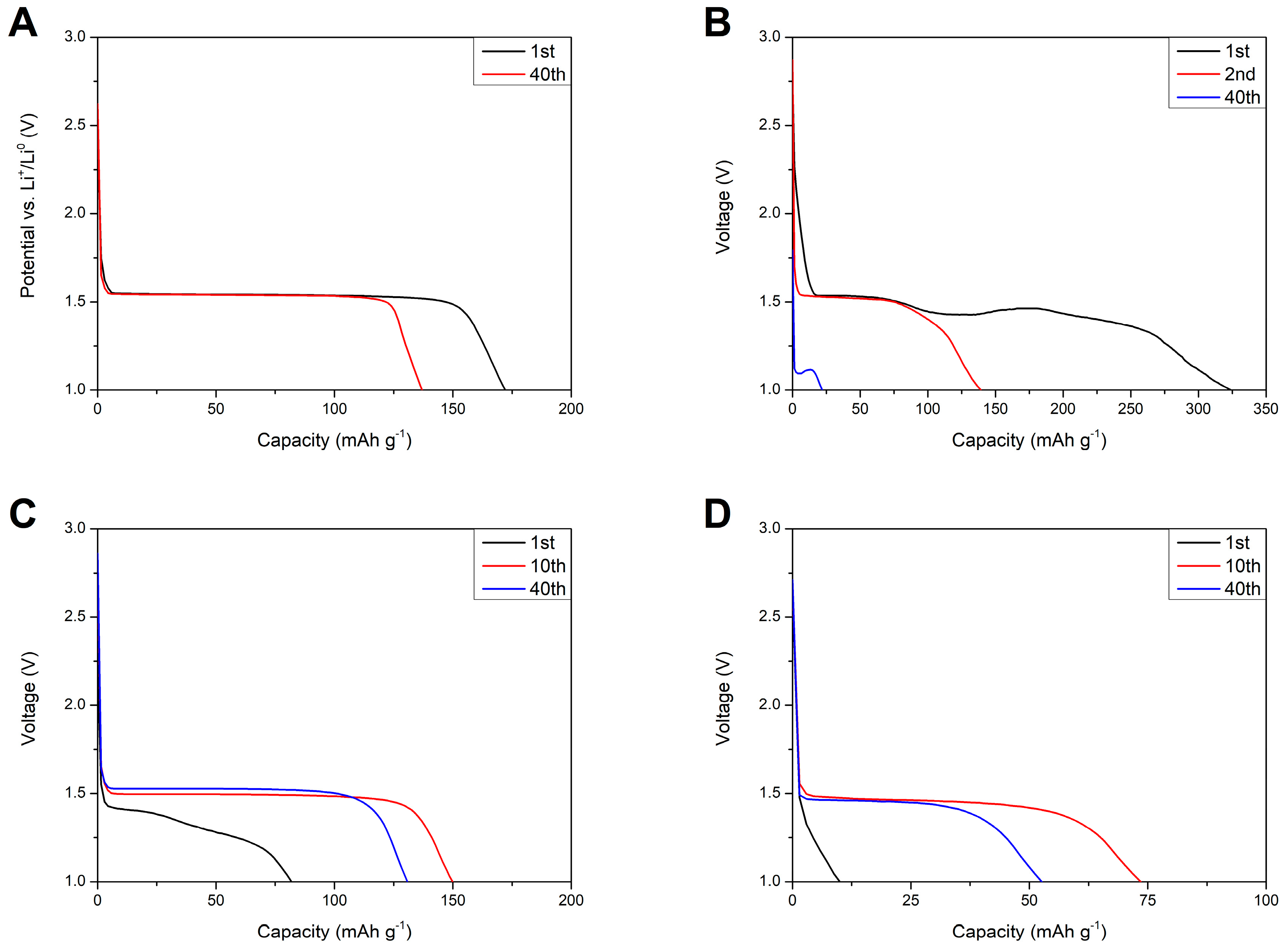
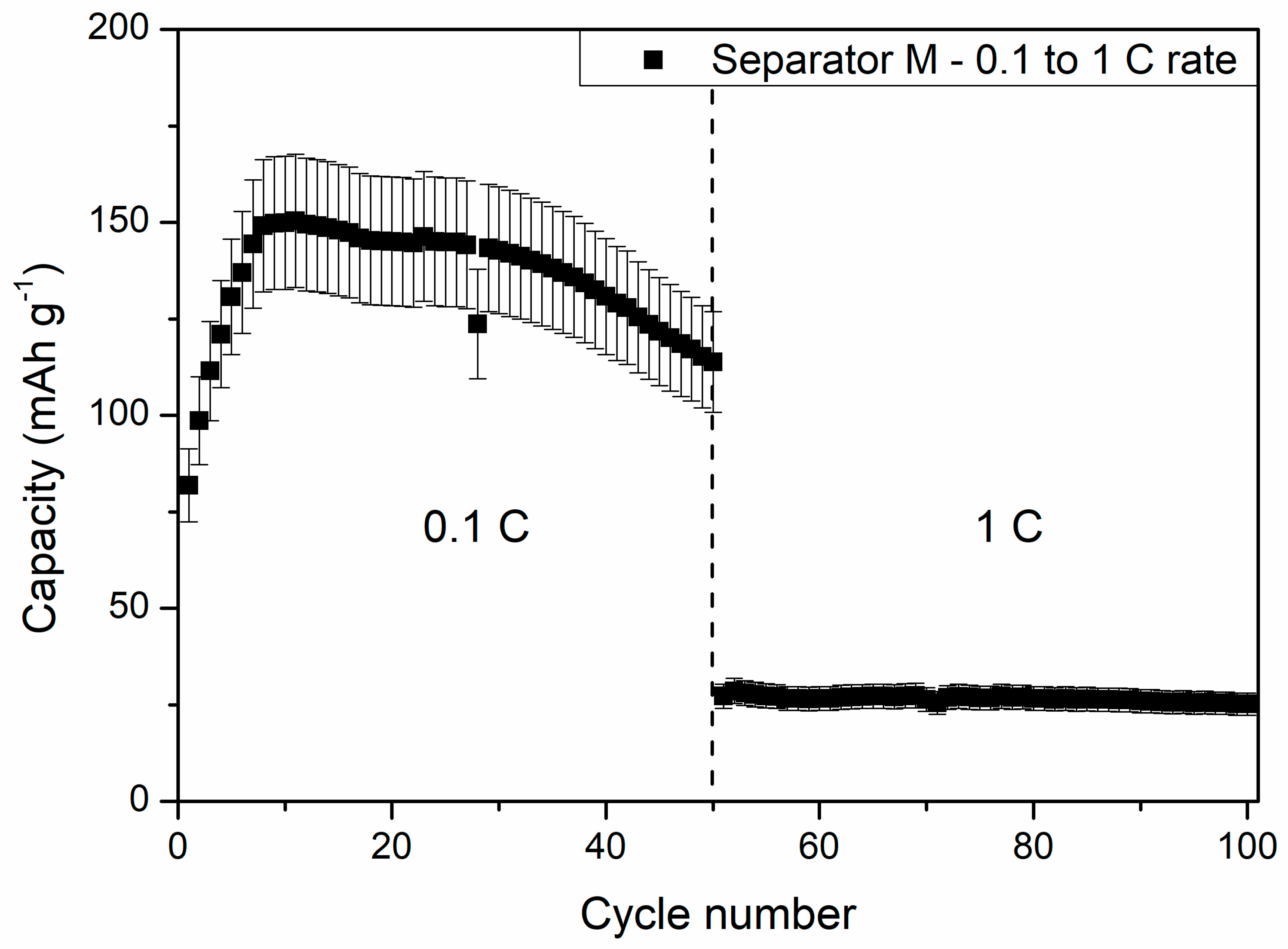
| Name and Properties | Structure | |
|---|---|---|
| 1. | Didecyldimethylammonium bis(trifluoromethylsulfonyl)imide (H2O content = 0.05%; Cl content < 0.01%) | 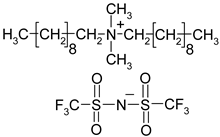 |
| 2. | Benzalkonium bis(trifluoromethylsulfonyl)imide (H2O content = 0.05%; Cl content < 0.01%) |  |
| 3. | Diallyldimethylammonium bis(trifluoromethylsulfonyl)imide (H2O content = 0.02%; Cl content < 0.01%) | 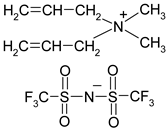 |
| 4. | Diallyldimethylammonium trifluoromethanesulfonate (H2O content = 0.07%; Cl content < 0.12%) | 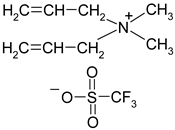 |
| 5. | 1-butyl-1-methylpyrrolidinium bis(trifluoromethylsulfonyl)imide (H2O content ≤ 0.04%; Cl content ≤ 0.005%) |  |
| 6. | 1-ethyl-3-methylimidazolium trifluoromethanesulfonate (H2O content ≤ 0.02%) | 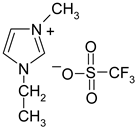 |
| Name of IL | Melting Point °C | Cold Crystallization Temperature °C | Tg °C | Comments |
|---|---|---|---|---|
| IL 1 | ca. −65 | None | −79.96 | Diffused melting point |
| IL 2 | −53.16 | None | −55.85 | - |
| IL 3 | −2.55 | −55.67 | −91.84 | Very sharp melting point |
| IL 3 (after UV curing) | None | None | +3.21 | - |
| IL 4 | −5.27 | −51.64 | −92.27 | Sharp melting point |
| IL 5 | −13.79 | −53.37 | −90.44 | Sharp melting point |
| IL 6 | −18.87 and −7.35 | −44.08 | −85.10 | Sharp melting and freezing points |
| Name of the Composite | Lithium Salt Anion | Solvent for Lithium Salt | Mass Proportion | Compound for Wetting the Film | Specific Conductivity Scm−1 × 10−4 | |
|---|---|---|---|---|---|---|
| Li Salt to Prepolymer | Solvent or/and IL to Prepolymer | |||||
| A | TFSI | EC/DMC = 1/2 | 1/5 | 4/5 | EC/DMC = 1/2 | 7.47 |
| B | TFSI | IL 5 | 1/5 | 4/5 | IL 5 | 0.63 |
| D | TFSI | IL 1 | 1/5 | 4/5 | IL 1 | 0.02 |
| D-D | TFSI | IL 1 | 1/5 | 4/5 | DMC | 1.47 |
| E | TFSI | IL 2/DMC =1/2 | 1/5 | 4/5 | DMC | 3.11 |
| E-C | TFSI | IL 2/DMC = 1/2 | 1/5 | 4/5 | IL 2 | 0.01 |
| F | TFSI | IL 5/DMC =1/2 | 1/5 | 4/5 | DMC | 3.92 |
| F-C | TFSI | IL 5/DMC = 1/2 | 1/5 | 4/5 | IL 5 | 0.14 |
| I | TFI | IL 6/DMC = 1/2 | 1/5 | 4/5 | DMC | 4.26 |
| I-C | TFI | IL 6 DMC = 1/2 | 1/5 | 4/5 | IL 6 | 0.66 |
| N | - | - | - | - | - | - |
| Name of the Composite | TgI °C | TgII °C | TgIII °C | Comments |
|---|---|---|---|---|
| A | −125.25 | −11.32 | None | - |
| B | −124.29 | −46.28 | +65.11 | TgIII—very weak signal |
| E | −123.43 | −23.47 | None | - |
| F | −125.96 | −15.02 | +49.56 to 82.56 | TgIII—very weak signal |
| I | −129.41 | −26.0 | +58.49 to 85.69 | TgIII—very weak signal |
| N | −126.93 | −27.47 | None | - |
| Name of the Composite | Lithium Salt Anion | Solvent for Lithium Salt | Mass Proportion | Compound for Wetting the Film | Specific Conductivity Scm−1 × 10−4 | |
|---|---|---|---|---|---|---|
| Li Salt to Prepolymer | Solvent or/and IL to Prepolymer | |||||
| A | TFSI | EC/DMC = 1/2 | 1/5 | 4/5 | EC/DMC = 1/2 | 7.47 |
| G | TFSI | IL 3/(EC/DMC = 1/2) = 1/3.5 | 1.5/4 | 4.5/4 | EC/DMC = 1/2 | 10.8 |
| G-C | TFSI | IL 3/(EC/DMC = 1/2) = 1/3.5 | 1.5/4 | 4.5/4 | IL 3 | 0.16 |
| G-D | TFSI | IL 3/(EC/DMC = 1/2) = 1/3.5 | 1.5/4 | 4.5/4 | DMC | 2.03 |
| H | TFI | IL 4/(EC/DMC = 1/2) = 1/4.2 | 0.8/4 | 5.2/4 | EC/DMC = 1/2 | 3.68 |
| K | TFSI | IL 3/(EC/DMC = 1/2) = 4/3.5 | 6/4 | 30/4 | IL 3 | 0.14 |
| K-D | TFSI | IL 3/(EC/DMC = 1/2) = 4/3.5 | 6/4 | 30/4 | DMC | 3.23 |
| M | TFSI | IL 3/IL 5 = 1/4 | 1/4 | 5/4 | IL 5 | 1.02 |
| M-D | TFSI | IL 3/IL 5 = 1/4 | 1/4 | 5/4 | DMC | 18.7 |
| M-CS | TFSI | IL 3/IL 5 = 1/4 | 1/4 | 5/4 | 1M IL 5 in 1M Li TFSI | 0.60 |
| N | - | - | - | - | - | - |
| Name of the Composite | TgI °C | TgII °C | TgIII °C | Comments |
|---|---|---|---|---|
| G | −125.48 | +3.09 | None | - |
| H | −129.00 | +10.93 | +32.87–56.06 | TgIII—very weak signal |
| I | −129.41 | −26.20 | +58.49–85.69 | TgIII—very weak signal |
| K | −119.35 | +11.04 | None | - |
| M | −125.53 | −46.52 | +124.13 | TgIII—very weak signal |
| N | −126.93 | −27.47 | None | - |
Publisher’s Note: MDPI stays neutral with regard to jurisdictional claims in published maps and institutional affiliations. |
© 2020 by the authors. Licensee MDPI, Basel, Switzerland. This article is an open access article distributed under the terms and conditions of the Creative Commons Attribution (CC BY) license (http://creativecommons.org/licenses/by/4.0/).
Share and Cite
Kozakiewicz, J.; Przybylski, J.; Hamankiewicz, B.; Sylwestrzak, K.; Trzaskowska, J.; Krajewski, M.; Ratyński, M.; Sarna, W.; Czerwiński, A. UV-Cured Poly(Siloxane-Urethane)-Based Polymer Composite Materials for Lithium Ion Batteries—The Effect of Modification with Ionic Liquids. Materials 2020, 13, 4978. https://doi.org/10.3390/ma13214978
Kozakiewicz J, Przybylski J, Hamankiewicz B, Sylwestrzak K, Trzaskowska J, Krajewski M, Ratyński M, Sarna W, Czerwiński A. UV-Cured Poly(Siloxane-Urethane)-Based Polymer Composite Materials for Lithium Ion Batteries—The Effect of Modification with Ionic Liquids. Materials. 2020; 13(21):4978. https://doi.org/10.3390/ma13214978
Chicago/Turabian StyleKozakiewicz, Janusz, Jarosław Przybylski, Bartosz Hamankiewicz, Krystyna Sylwestrzak, Joanna Trzaskowska, Michal Krajewski, Maciej Ratyński, Witold Sarna, and Andrzej Czerwiński. 2020. "UV-Cured Poly(Siloxane-Urethane)-Based Polymer Composite Materials for Lithium Ion Batteries—The Effect of Modification with Ionic Liquids" Materials 13, no. 21: 4978. https://doi.org/10.3390/ma13214978
APA StyleKozakiewicz, J., Przybylski, J., Hamankiewicz, B., Sylwestrzak, K., Trzaskowska, J., Krajewski, M., Ratyński, M., Sarna, W., & Czerwiński, A. (2020). UV-Cured Poly(Siloxane-Urethane)-Based Polymer Composite Materials for Lithium Ion Batteries—The Effect of Modification with Ionic Liquids. Materials, 13(21), 4978. https://doi.org/10.3390/ma13214978








